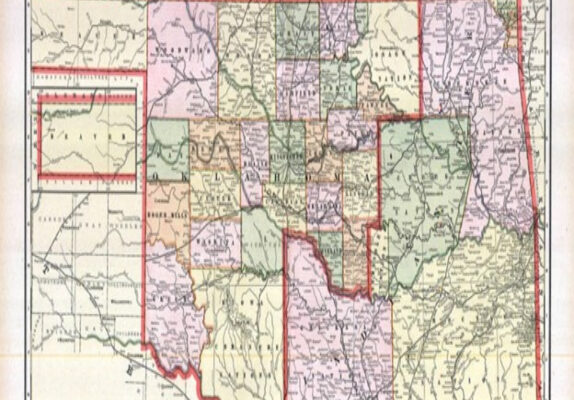Regular reader and valued ID commenter, Outside Looking In, recently asked of me (here) which part(s) of my native State comprise the Confederate part(s).
This is a great question I have been asked, and have answered, many times over the last fifteen or so years. However, when I’m pressed for time and/or space (such as in a combox), my answer to the question is always woefully incomplete; it is very simply to procure a map of the state and, beginning at the state’s northeast terminus, to draw an imaginary line from there to the southwest terminus of same. The territory south and east of the line being the Confederate part; the territory north and west (including the panhandle) being the Unionist part of the state.
Now, there is some irregular overlap on both sides of the line in the foregoing demarcation, but the model is nevertheless a close approximation. If you are one familiar with the old pre-statehood (pre-November, 1907) maps of the Indian and Oklahoma Territories, they give an even closer approximation, distinguishing those areas of the state originally settled by Southerners, versus those parts originally settled by their Northern counterparts. On those maps in particular, the Indian Territories previously allotted to the Chickasaw, Choctaw, Cherokee and the Creek tribes, are all Confederate territories for purposes of answering the question.
There are a number of reliable ways by which one may verify this information, one of which is the 13th United States Census taken in the counties and precincts scattered about in Oklahoma in 1910. One column (column #30) on that document having been devoted explicitly to enumerating “Whether a Survivor of the Union or Confederate Army or Navy.” Survivors who served the Union being identified in the column by the initials “Ua” (Union Army) or “Un” (Union Navy); whereas survivors who served the right side of that conflict are alternatively identified as “Ca” (Confederate Army) or “Cn” (Confederate Navy) on the document. County-by-county and precinct-by-precinct examinations of these documents for the State of Oklahoma (1910 Federal Census) verify the lines of demarcation as above alluded to. Here is a sample:


Earl Township, Jefferson Co, OK, 1910
Another way of verifying the information previously given is to examine the list of “Confederate Cards” on file in the State’s Historical Society database, and to compare the locations in the state of the pensioners in that file to the lines of demarcation previously established. A typical card in the file is seen below. I chose this particular card as my example because it was issued in the name of my 2nd great-grandmother on my father’s side of the family, Elizabeth Jane Singleton Pruitt, who received a Confederate Widow’s Pension in Oklahoma from 1924-1941, as entered on the card:

1910 was also the year construction of the Confederate Home of Ardmore, OK was completed. The home was opened in 1911. The home’s location in the heart of that area of the State once commonly referred to as “Little Dixie” is further confirmation of the facts given above. I wrote about the home at this site, October 19, 2020; I later wrote about two of the home’s most active and important benefactors on March 15, 2021, here.
As a crow flies, the home of my 2nd great-grandmother above-mentioned was between five and six miles almost due west of where the Confederate Home of Ardmore still stands, although she was taken care of by family in her extreme old age, and was therefore never an inmate there. A section of Rose Hill Cemetery of the same city (Ardmore) contains the graves of upwards of four hundred (400+) of Confederates and/or their widows who were inmates of the home and who died while residing there. Here is a photo of the home at its dedication ceremonies in 1910:

Forts Washita (Durant) and Gibson, as well as Confederate supply depots such as Boggy Depot near Atoka and Bugtussle Depot near McAlester, etc., also bear witness to the facts previously given. And speaking of McAlester, for many years the town was known as the Capitol of Little Dixie, no doubt due to its central location in the heart of Little Dixie, coupled with its founding by prominent ex-Confederates and their sons. Additionally, McAlester served as the base of operations from which Commander Daniel M. Hailey published the annual Record of Confederate Veterans of the State of Oklahoma until his death:

Of course the number of Confederate graves and those of their spouses and children that grace the many cemeteries within the boundaries of Little Dixie also bear witness to the facts as given above.
There you have it, brothers and sisters, the southern and eastern parts of Oklahoma are in fact Southern and Confederate, by the Grace of God! My eternal thanks to Outside Looking In for the question as he posed it, and to our worthy editor for publishing my answer to the query. If ever I am asked the question in the future, I will simply direct the inquisitor to this article.
God Bless Little Dixie!







God Bless you Mr. Morris!
My Kin ended up in Arkansas after migrating from Virginia, I’m guessing, they came over from Britain on the H.M.S or SS Vine in 1685 I do remember correctly. I was going to move back to the Ozarks and just roll through Oklahoma before I had read your article about the Confederate nursing home years ago, and the union and confederate parts of your state. I had no idea. You had mentioned the Red river in your ill fated hang glider experience, that is the Texas-Oklahoma border region is it not? I need to get an Atlas for I am working remote right now and I still have no search engine capability on this device.
When covid hit the U.S, every city in this country took a massive dump on the N.W., then add the international vultures whom came here and bought everything up, it really was a kick to the nuts for a man this side of retirement age. Can a man still homestead Oklahoma without being turned into a slave like out west here?
It is very humbling to be on Identity Dixie and to be called a valued commenter, I hope to live up to that compliment. Thank you for your reply to my question.
God Bless you again Sir, and God Bless Little Dixie!
What I’m reading right now, ironically, speaks to my attitude.
Salvian Compares the Barbaric Culture with the Failing Roman way of life.
(Salvian, of God’s Government, 440)
‘In what respect can our customs be preferred to those of the Goths and Vandals, or even compared with them? To speak of affection and charity, almost all barbarians, at least those that are one race and kin, love each other, while the Romans persecute each other. For what citizen does not envy his fellow citizen. What citizen shows to his neighbor full love and charity? And it is even worse than that; for the many are mistreated by the few, who regard public exactions as their own peculiar right, who carry on private traffic under the guise of collecting the taxes. And this is done by not only the Nobles, but by the judges and their subordinates. For where in the Empire is the City—or even the town or village—which has not as many tyrants as it has curiales? What place is there, therefore, where the substance of widows and orphans, or even Saints, is not devoured by the chief citizens?…………….’
From the book. European Civilization. Basic historical documents. Paul L.Hughes & Robert F. Fries, 1965, first edition was 1956. p.8.
Continued from above-
Even those in a position to protest against the iniquity which they see about them dare not speak lest they make matters worse than before. So the poor are despoiled, the widows sigh, the orphans are oppressed, until many of them, born of Roman families, and educated, flee to our enemies that they may no longer suffer the oppression of public persecution. They doubtless seek Roman humanity amongst the barbarians because they cannot bear barbarian inhumanity among the Romans.
So they migrate to the Goths, or to the burgundians, or to some other tribe of barbarians who are ruling everywhere, and do not regret their exile. For they would rather live free under an appearance of slavery than live as captives under an appearance of liberty. The name of Roman citizen, once so highly esteemed and so dearly bought, is now a thing that men repudiate and flee from.
Yes, the Red River separates Oklahoma & Texas at Oklahoma’s southernmost border. It’s not as easy, nor as affordable, to homestead in Oklahoma as it once was before the people voted in the medical marijuana law and opened the state to migratory Chinese land grabbers looking to get richer from operating “grow farms” here, but it can still be done, yes. Also, Oklahoma happens to be the least regulated state when it comes to Homeschooling one’s children. The only problem with that ‘claim to fame’ is that it attracts “human capital” of a sort that most native Okies would prefer never come here for any reason, particularly that one. It’s akin to enticing corporations to come here by offering them huge tax breaks, and the next thing you know Oklahoma is being invaded by foreigners and Yankees of the worst sorts, if you know what I mean.
Mr. Morris.
“Remove not the ancient landmarks”
It is so refreshing to see monuments to our ancestors described in your article, the closest thing out west here would be an old pizza hut building, I am not joking. It speaks volumes to the short sighted Yankee character, and what was lost, for now, In 1865.
Thank you again for taking the time to write that article, looking forward to more of them from you.
God Bless and Save the South!
I’m glad you mentioned this, sir! It was my intention to mention the Confederate monument that still graces the courthouse lawn in Durant, and to add a link to a photo of same in the 0.P., but I failed to do so and I regret that now. However, your comment provides opportunity to redeem myself of that failure in the comments here. And here is the link to the photo of the monument I intended to add to the O.P. to boot:
https://en.wikipedia.org/wiki/Bryan_County_Courthouse_(Oklahoma)#/media/File%3ADurant_June_2018_02_(Bryan_County_Courthouse).jpg
In a future Confederacy, it seems to me that the emphasis, at least in the near term, would be on preserving historic Confederate ethnic stock and what remains of Southern Culture. Therefore, I don’t think that state lines should be the controlling factor. Thus a Confederate Texas would mostly consist of the counties of East Texas, and SE Oklahoma should either be a separate Confederate state or joined with another Confederate state.
Once a firm foundation is established and protected, it would be possible to regain additional territory as the former U.S. continues to unwind.
Well, that’s a related but different matter than the one I discuss in the O.P..
I could have broached that topic in part by discussing the facts surrounding application for statehood itself for example (e.g. that the original plan was to apply for statehood as two separate states instead of combining Oklahoma and Indian Territories into one), but that was not my purpose in writing the post. The purpose was, as I say in the O.P., to answer Outside Looking In’s question first and foremost, and, in so going, to avoid having to repeat the information when someone asks the question of me going forward. Which is an inevitability, and at which time I will send the individual(s) to read the post.
But thanks for the comment in any case, sir.